Role Strain and Burnout in Nursing
VerifiedAdded on 2022/12/23
|7
|1592
|3
AI Summary
This article discusses the effects of role strain and burnout in nursing, including its impact on patient care and the ethical and legal issues involved. It also provides strategies for nurses to manage and reduce role stress and strain. The article emphasizes the importance of addressing these issues to ensure quality patient care and professional standards.
Contribute Materials
Your contribution can guide someone’s learning journey. Share your
documents today.
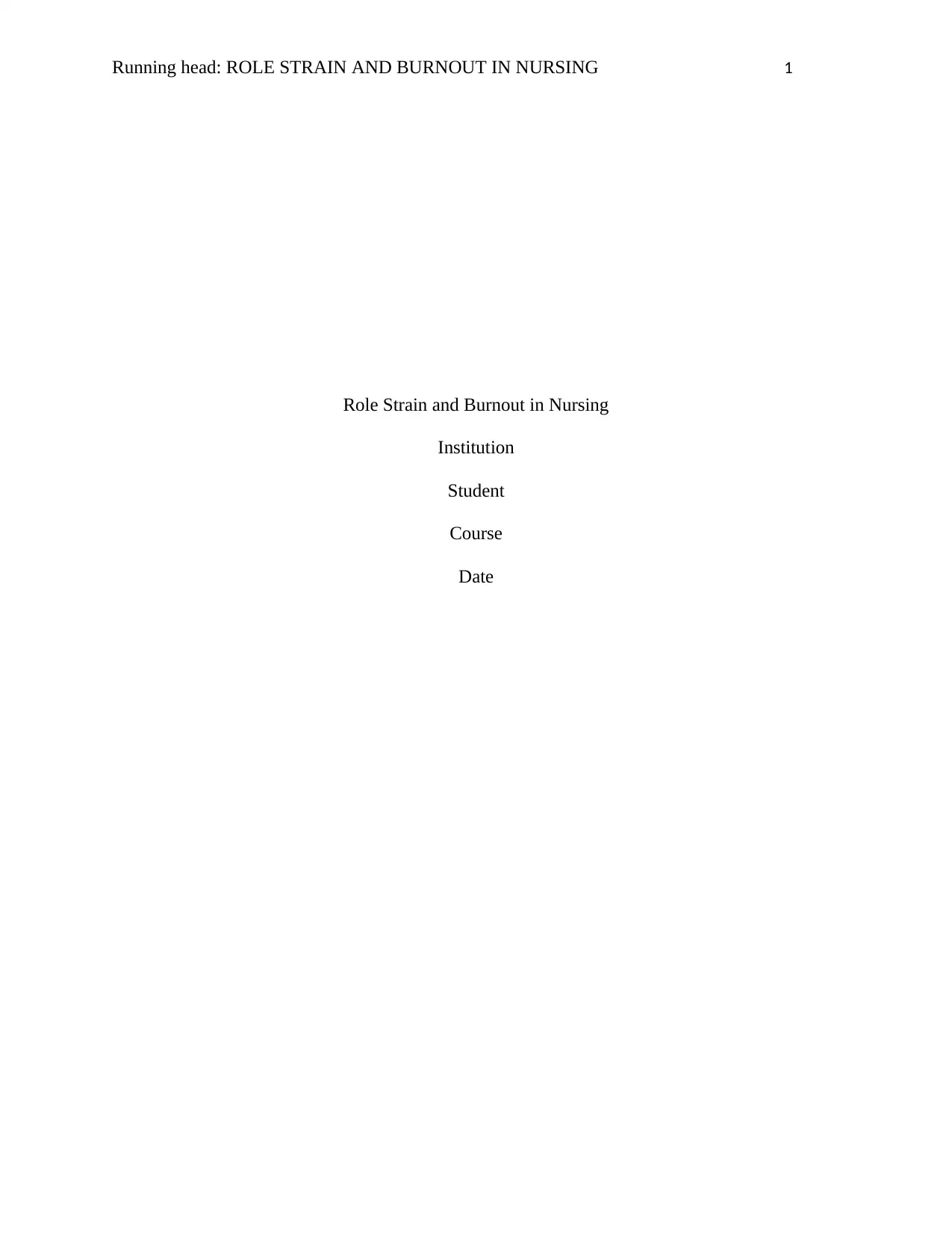
Running head: ROLE STRAIN AND BURNOUT IN NURSING 1
Role Strain and Burnout in Nursing
Institution
Student
Course
Date
Role Strain and Burnout in Nursing
Institution
Student
Course
Date
Secure Best Marks with AI Grader
Need help grading? Try our AI Grader for instant feedback on your assignments.
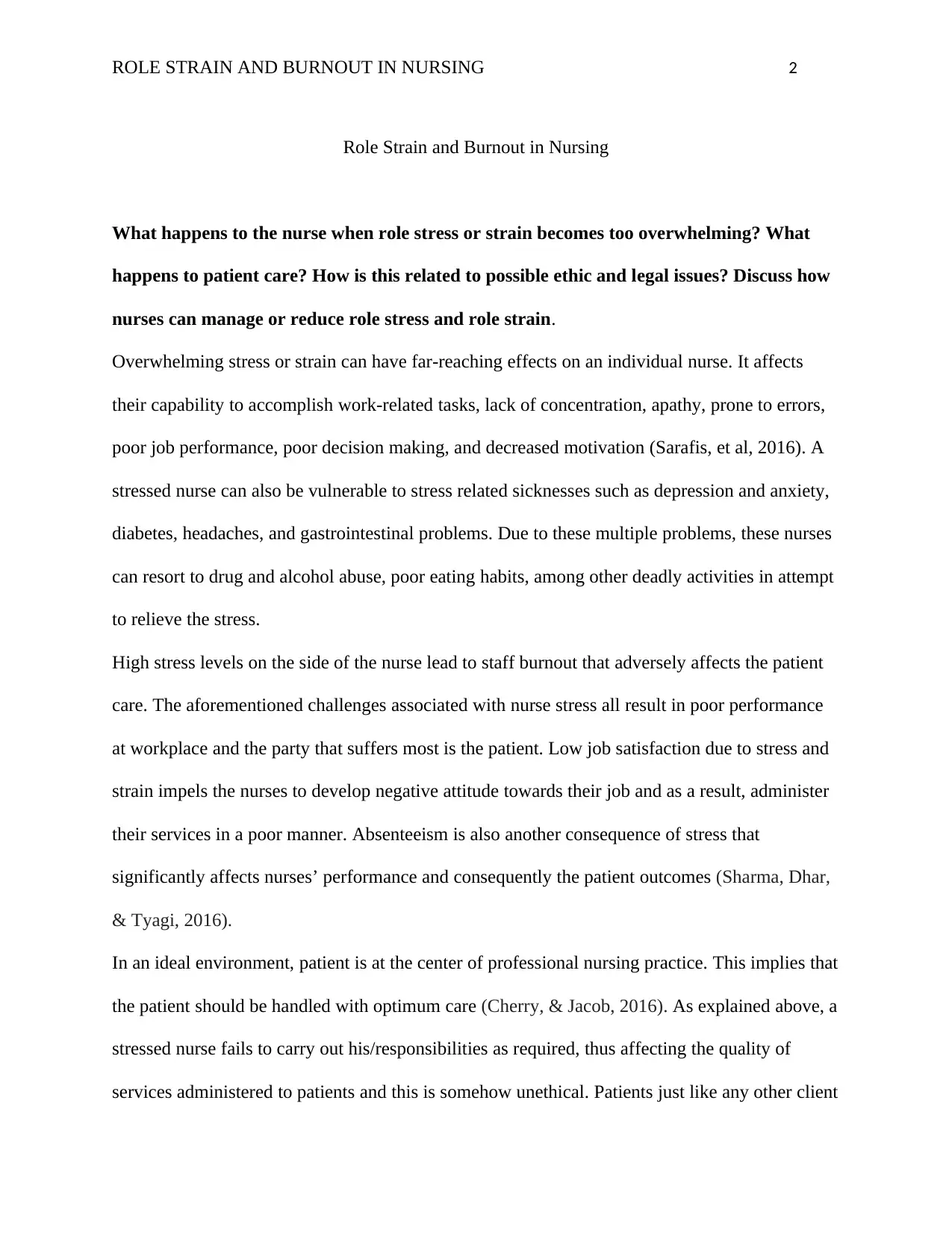
ROLE STRAIN AND BURNOUT IN NURSING 2
Role Strain and Burnout in Nursing
What happens to the nurse when role stress or strain becomes too overwhelming? What
happens to patient care? How is this related to possible ethic and legal issues? Discuss how
nurses can manage or reduce role stress and role strain.
Overwhelming stress or strain can have far-reaching effects on an individual nurse. It affects
their capability to accomplish work-related tasks, lack of concentration, apathy, prone to errors,
poor job performance, poor decision making, and decreased motivation (Sarafis, et al, 2016). A
stressed nurse can also be vulnerable to stress related sicknesses such as depression and anxiety,
diabetes, headaches, and gastrointestinal problems. Due to these multiple problems, these nurses
can resort to drug and alcohol abuse, poor eating habits, among other deadly activities in attempt
to relieve the stress.
High stress levels on the side of the nurse lead to staff burnout that adversely affects the patient
care. The aforementioned challenges associated with nurse stress all result in poor performance
at workplace and the party that suffers most is the patient. Low job satisfaction due to stress and
strain impels the nurses to develop negative attitude towards their job and as a result, administer
their services in a poor manner. Absenteeism is also another consequence of stress that
significantly affects nurses’ performance and consequently the patient outcomes (Sharma, Dhar,
& Tyagi, 2016).
In an ideal environment, patient is at the center of professional nursing practice. This implies that
the patient should be handled with optimum care (Cherry, & Jacob, 2016). As explained above, a
stressed nurse fails to carry out his/responsibilities as required, thus affecting the quality of
services administered to patients and this is somehow unethical. Patients just like any other client
Role Strain and Burnout in Nursing
What happens to the nurse when role stress or strain becomes too overwhelming? What
happens to patient care? How is this related to possible ethic and legal issues? Discuss how
nurses can manage or reduce role stress and role strain.
Overwhelming stress or strain can have far-reaching effects on an individual nurse. It affects
their capability to accomplish work-related tasks, lack of concentration, apathy, prone to errors,
poor job performance, poor decision making, and decreased motivation (Sarafis, et al, 2016). A
stressed nurse can also be vulnerable to stress related sicknesses such as depression and anxiety,
diabetes, headaches, and gastrointestinal problems. Due to these multiple problems, these nurses
can resort to drug and alcohol abuse, poor eating habits, among other deadly activities in attempt
to relieve the stress.
High stress levels on the side of the nurse lead to staff burnout that adversely affects the patient
care. The aforementioned challenges associated with nurse stress all result in poor performance
at workplace and the party that suffers most is the patient. Low job satisfaction due to stress and
strain impels the nurses to develop negative attitude towards their job and as a result, administer
their services in a poor manner. Absenteeism is also another consequence of stress that
significantly affects nurses’ performance and consequently the patient outcomes (Sharma, Dhar,
& Tyagi, 2016).
In an ideal environment, patient is at the center of professional nursing practice. This implies that
the patient should be handled with optimum care (Cherry, & Jacob, 2016). As explained above, a
stressed nurse fails to carry out his/responsibilities as required, thus affecting the quality of
services administered to patients and this is somehow unethical. Patients just like any other client
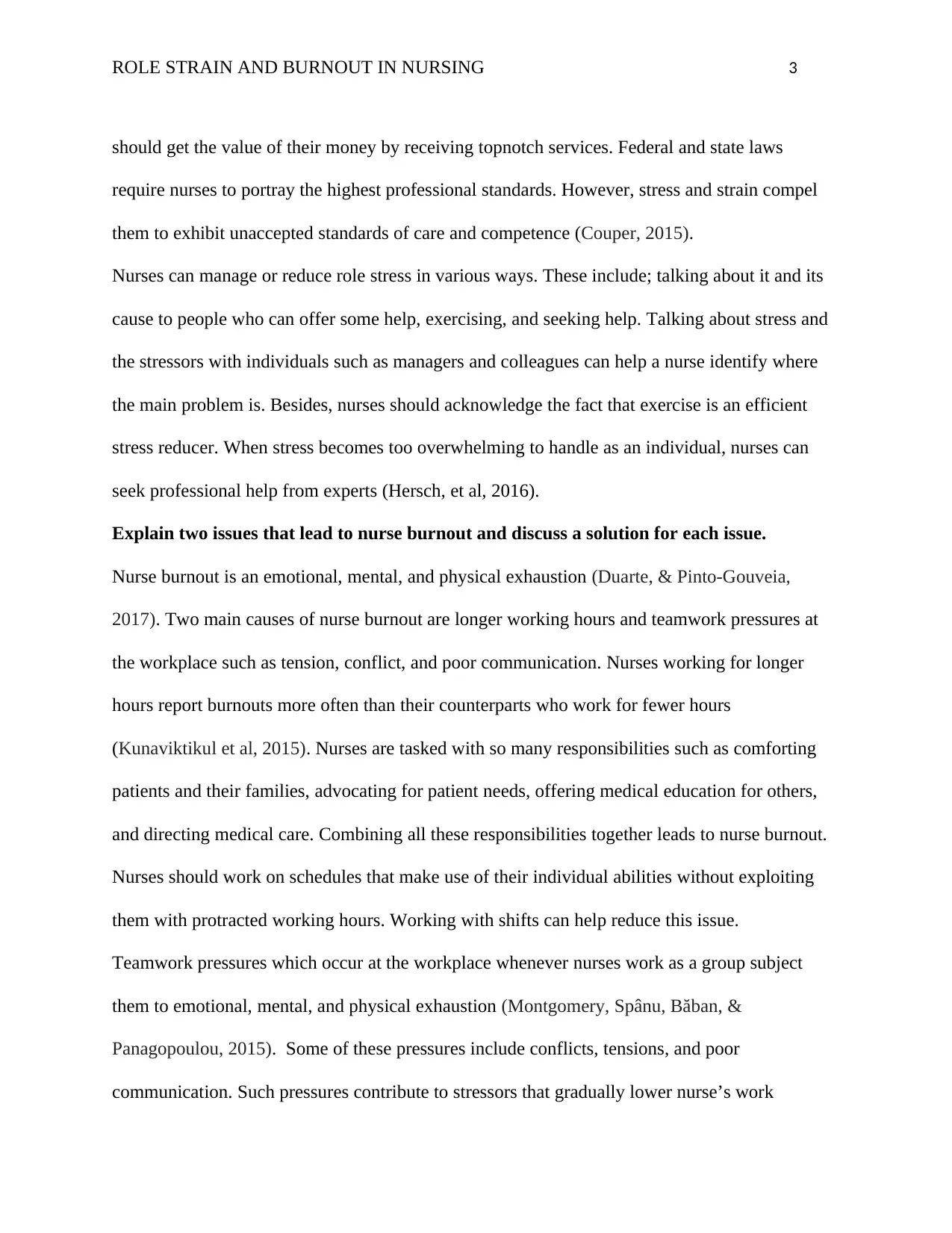
ROLE STRAIN AND BURNOUT IN NURSING 3
should get the value of their money by receiving topnotch services. Federal and state laws
require nurses to portray the highest professional standards. However, stress and strain compel
them to exhibit unaccepted standards of care and competence (Couper, 2015).
Nurses can manage or reduce role stress in various ways. These include; talking about it and its
cause to people who can offer some help, exercising, and seeking help. Talking about stress and
the stressors with individuals such as managers and colleagues can help a nurse identify where
the main problem is. Besides, nurses should acknowledge the fact that exercise is an efficient
stress reducer. When stress becomes too overwhelming to handle as an individual, nurses can
seek professional help from experts (Hersch, et al, 2016).
Explain two issues that lead to nurse burnout and discuss a solution for each issue.
Nurse burnout is an emotional, mental, and physical exhaustion (Duarte, & Pinto-Gouveia,
2017). Two main causes of nurse burnout are longer working hours and teamwork pressures at
the workplace such as tension, conflict, and poor communication. Nurses working for longer
hours report burnouts more often than their counterparts who work for fewer hours
(Kunaviktikul et al, 2015). Nurses are tasked with so many responsibilities such as comforting
patients and their families, advocating for patient needs, offering medical education for others,
and directing medical care. Combining all these responsibilities together leads to nurse burnout.
Nurses should work on schedules that make use of their individual abilities without exploiting
them with protracted working hours. Working with shifts can help reduce this issue.
Teamwork pressures which occur at the workplace whenever nurses work as a group subject
them to emotional, mental, and physical exhaustion (Montgomery, Spânu, Băban, &
Panagopoulou, 2015). Some of these pressures include conflicts, tensions, and poor
communication. Such pressures contribute to stressors that gradually lower nurse’s work
should get the value of their money by receiving topnotch services. Federal and state laws
require nurses to portray the highest professional standards. However, stress and strain compel
them to exhibit unaccepted standards of care and competence (Couper, 2015).
Nurses can manage or reduce role stress in various ways. These include; talking about it and its
cause to people who can offer some help, exercising, and seeking help. Talking about stress and
the stressors with individuals such as managers and colleagues can help a nurse identify where
the main problem is. Besides, nurses should acknowledge the fact that exercise is an efficient
stress reducer. When stress becomes too overwhelming to handle as an individual, nurses can
seek professional help from experts (Hersch, et al, 2016).
Explain two issues that lead to nurse burnout and discuss a solution for each issue.
Nurse burnout is an emotional, mental, and physical exhaustion (Duarte, & Pinto-Gouveia,
2017). Two main causes of nurse burnout are longer working hours and teamwork pressures at
the workplace such as tension, conflict, and poor communication. Nurses working for longer
hours report burnouts more often than their counterparts who work for fewer hours
(Kunaviktikul et al, 2015). Nurses are tasked with so many responsibilities such as comforting
patients and their families, advocating for patient needs, offering medical education for others,
and directing medical care. Combining all these responsibilities together leads to nurse burnout.
Nurses should work on schedules that make use of their individual abilities without exploiting
them with protracted working hours. Working with shifts can help reduce this issue.
Teamwork pressures which occur at the workplace whenever nurses work as a group subject
them to emotional, mental, and physical exhaustion (Montgomery, Spânu, Băban, &
Panagopoulou, 2015). Some of these pressures include conflicts, tensions, and poor
communication. Such pressures contribute to stressors that gradually lower nurse’s work
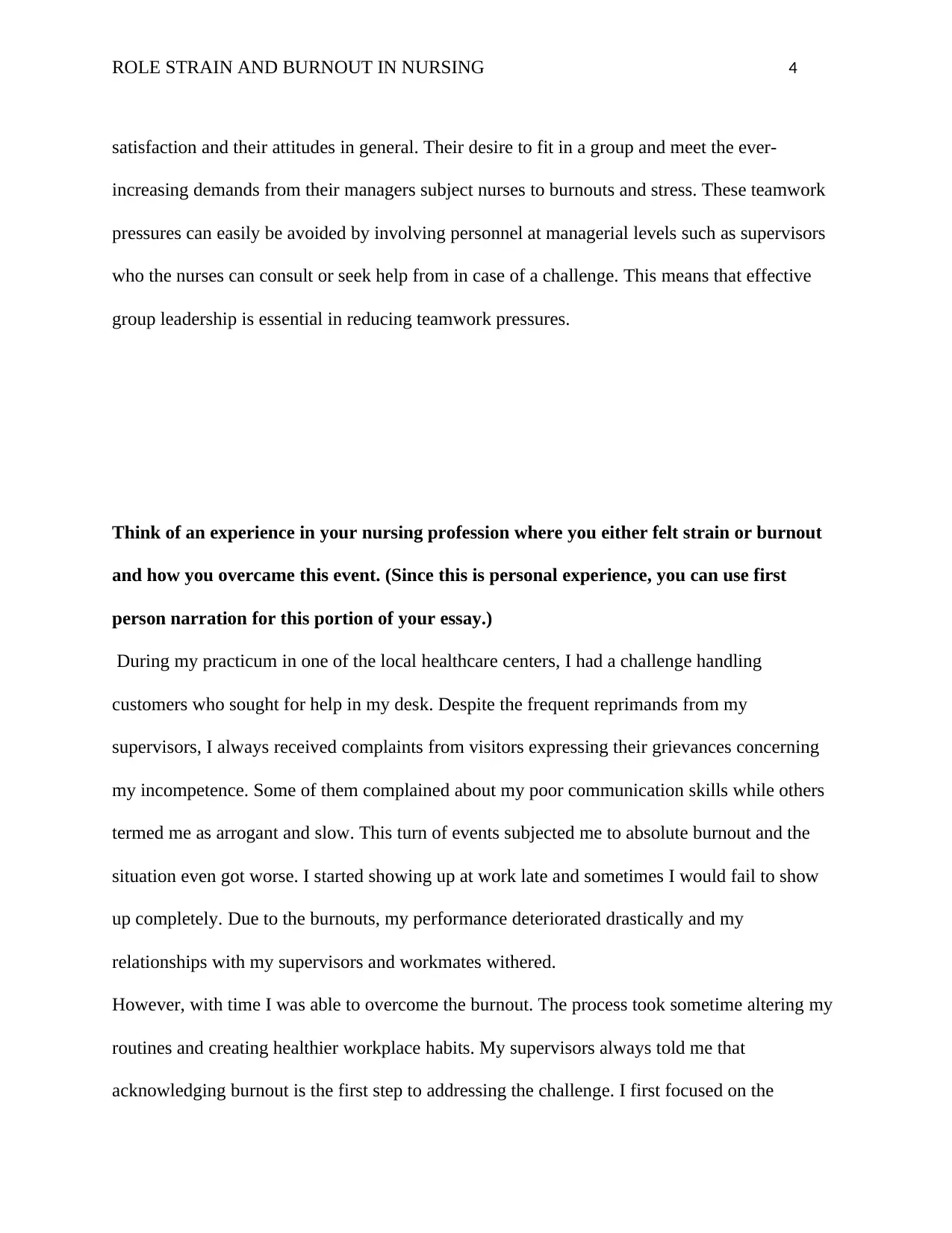
ROLE STRAIN AND BURNOUT IN NURSING 4
satisfaction and their attitudes in general. Their desire to fit in a group and meet the ever-
increasing demands from their managers subject nurses to burnouts and stress. These teamwork
pressures can easily be avoided by involving personnel at managerial levels such as supervisors
who the nurses can consult or seek help from in case of a challenge. This means that effective
group leadership is essential in reducing teamwork pressures.
Think of an experience in your nursing profession where you either felt strain or burnout
and how you overcame this event. (Since this is personal experience, you can use first
person narration for this portion of your essay.)
During my practicum in one of the local healthcare centers, I had a challenge handling
customers who sought for help in my desk. Despite the frequent reprimands from my
supervisors, I always received complaints from visitors expressing their grievances concerning
my incompetence. Some of them complained about my poor communication skills while others
termed me as arrogant and slow. This turn of events subjected me to absolute burnout and the
situation even got worse. I started showing up at work late and sometimes I would fail to show
up completely. Due to the burnouts, my performance deteriorated drastically and my
relationships with my supervisors and workmates withered.
However, with time I was able to overcome the burnout. The process took sometime altering my
routines and creating healthier workplace habits. My supervisors always told me that
acknowledging burnout is the first step to addressing the challenge. I first focused on the
satisfaction and their attitudes in general. Their desire to fit in a group and meet the ever-
increasing demands from their managers subject nurses to burnouts and stress. These teamwork
pressures can easily be avoided by involving personnel at managerial levels such as supervisors
who the nurses can consult or seek help from in case of a challenge. This means that effective
group leadership is essential in reducing teamwork pressures.
Think of an experience in your nursing profession where you either felt strain or burnout
and how you overcame this event. (Since this is personal experience, you can use first
person narration for this portion of your essay.)
During my practicum in one of the local healthcare centers, I had a challenge handling
customers who sought for help in my desk. Despite the frequent reprimands from my
supervisors, I always received complaints from visitors expressing their grievances concerning
my incompetence. Some of them complained about my poor communication skills while others
termed me as arrogant and slow. This turn of events subjected me to absolute burnout and the
situation even got worse. I started showing up at work late and sometimes I would fail to show
up completely. Due to the burnouts, my performance deteriorated drastically and my
relationships with my supervisors and workmates withered.
However, with time I was able to overcome the burnout. The process took sometime altering my
routines and creating healthier workplace habits. My supervisors always told me that
acknowledging burnout is the first step to addressing the challenge. I first focused on the
Secure Best Marks with AI Grader
Need help grading? Try our AI Grader for instant feedback on your assignments.
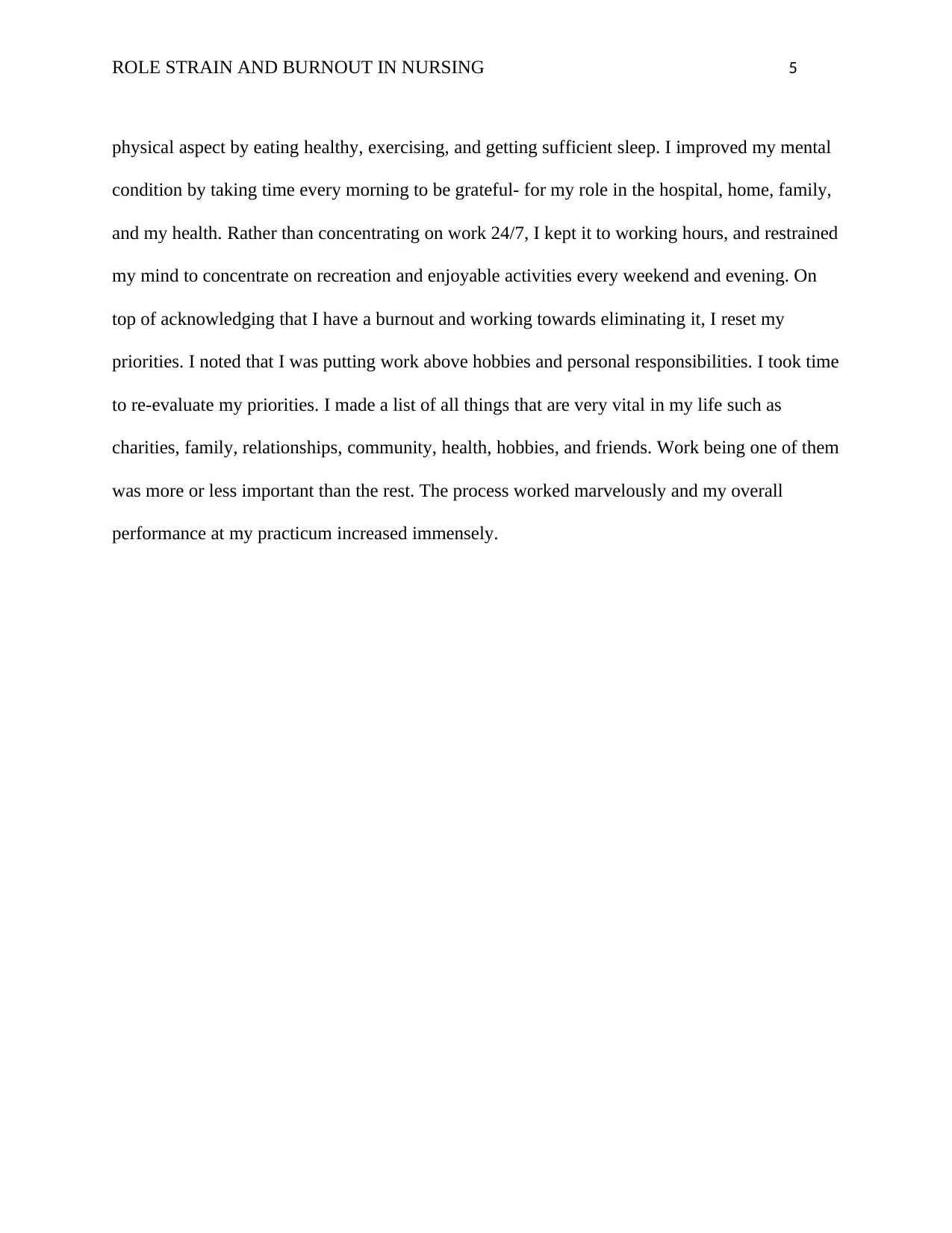
ROLE STRAIN AND BURNOUT IN NURSING 5
physical aspect by eating healthy, exercising, and getting sufficient sleep. I improved my mental
condition by taking time every morning to be grateful- for my role in the hospital, home, family,
and my health. Rather than concentrating on work 24/7, I kept it to working hours, and restrained
my mind to concentrate on recreation and enjoyable activities every weekend and evening. On
top of acknowledging that I have a burnout and working towards eliminating it, I reset my
priorities. I noted that I was putting work above hobbies and personal responsibilities. I took time
to re-evaluate my priorities. I made a list of all things that are very vital in my life such as
charities, family, relationships, community, health, hobbies, and friends. Work being one of them
was more or less important than the rest. The process worked marvelously and my overall
performance at my practicum increased immensely.
physical aspect by eating healthy, exercising, and getting sufficient sleep. I improved my mental
condition by taking time every morning to be grateful- for my role in the hospital, home, family,
and my health. Rather than concentrating on work 24/7, I kept it to working hours, and restrained
my mind to concentrate on recreation and enjoyable activities every weekend and evening. On
top of acknowledging that I have a burnout and working towards eliminating it, I reset my
priorities. I noted that I was putting work above hobbies and personal responsibilities. I took time
to re-evaluate my priorities. I made a list of all things that are very vital in my life such as
charities, family, relationships, community, health, hobbies, and friends. Work being one of them
was more or less important than the rest. The process worked marvelously and my overall
performance at my practicum increased immensely.
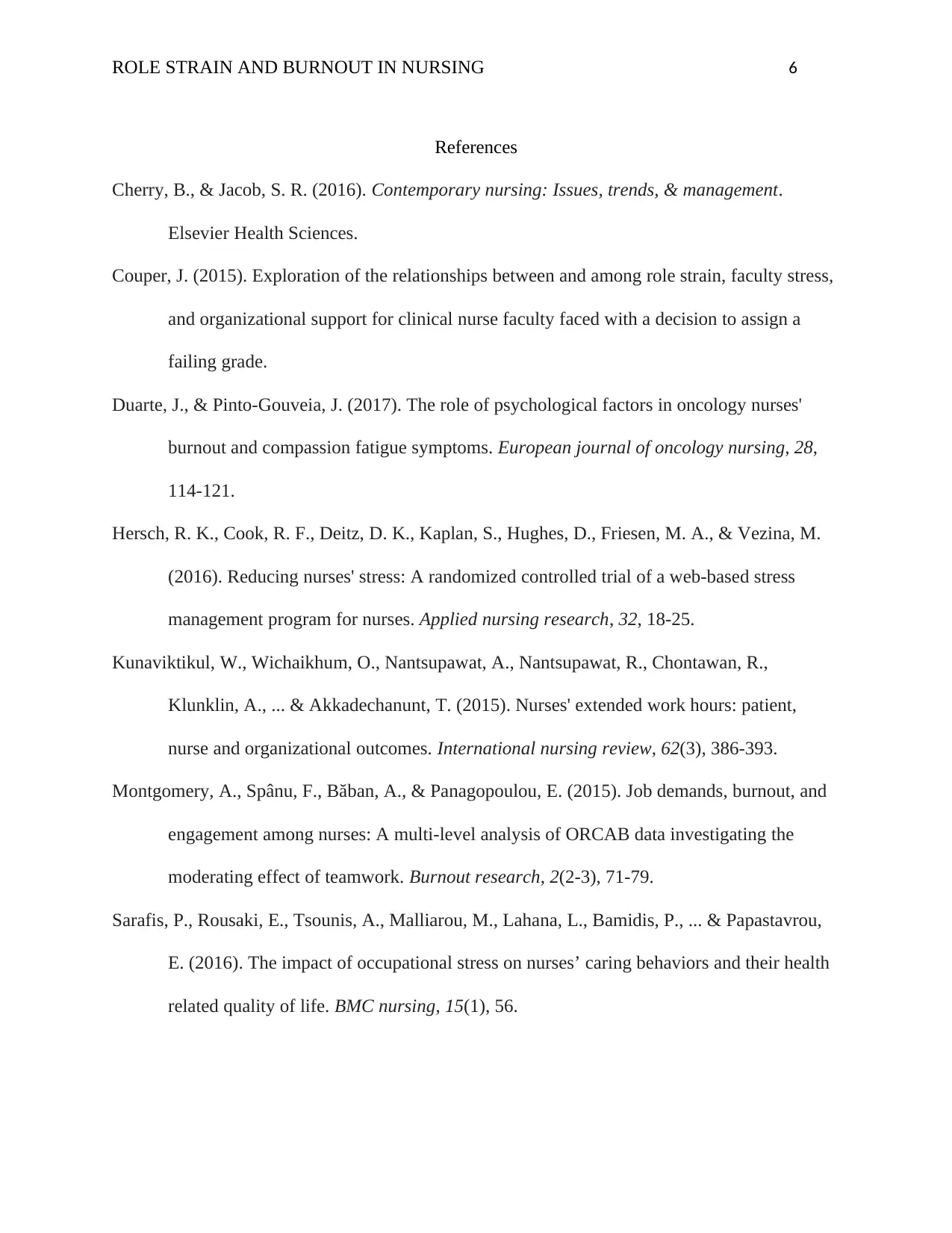
ROLE STRAIN AND BURNOUT IN NURSING 6
References
Cherry, B., & Jacob, S. R. (2016). Contemporary nursing: Issues, trends, & management.
Elsevier Health Sciences.
Couper, J. (2015). Exploration of the relationships between and among role strain, faculty stress,
and organizational support for clinical nurse faculty faced with a decision to assign a
failing grade.
Duarte, J., & Pinto-Gouveia, J. (2017). The role of psychological factors in oncology nurses'
burnout and compassion fatigue symptoms. European journal of oncology nursing, 28,
114-121.
Hersch, R. K., Cook, R. F., Deitz, D. K., Kaplan, S., Hughes, D., Friesen, M. A., & Vezina, M.
(2016). Reducing nurses' stress: A randomized controlled trial of a web-based stress
management program for nurses. Applied nursing research, 32, 18-25.
Kunaviktikul, W., Wichaikhum, O., Nantsupawat, A., Nantsupawat, R., Chontawan, R.,
Klunklin, A., ... & Akkadechanunt, T. (2015). Nurses' extended work hours: patient,
nurse and organizational outcomes. International nursing review, 62(3), 386-393.
Montgomery, A., Spânu, F., Băban, A., & Panagopoulou, E. (2015). Job demands, burnout, and
engagement among nurses: A multi-level analysis of ORCAB data investigating the
moderating effect of teamwork. Burnout research, 2(2-3), 71-79.
Sarafis, P., Rousaki, E., Tsounis, A., Malliarou, M., Lahana, L., Bamidis, P., ... & Papastavrou,
E. (2016). The impact of occupational stress on nurses’ caring behaviors and their health
related quality of life. BMC nursing, 15(1), 56.
References
Cherry, B., & Jacob, S. R. (2016). Contemporary nursing: Issues, trends, & management.
Elsevier Health Sciences.
Couper, J. (2015). Exploration of the relationships between and among role strain, faculty stress,
and organizational support for clinical nurse faculty faced with a decision to assign a
failing grade.
Duarte, J., & Pinto-Gouveia, J. (2017). The role of psychological factors in oncology nurses'
burnout and compassion fatigue symptoms. European journal of oncology nursing, 28,
114-121.
Hersch, R. K., Cook, R. F., Deitz, D. K., Kaplan, S., Hughes, D., Friesen, M. A., & Vezina, M.
(2016). Reducing nurses' stress: A randomized controlled trial of a web-based stress
management program for nurses. Applied nursing research, 32, 18-25.
Kunaviktikul, W., Wichaikhum, O., Nantsupawat, A., Nantsupawat, R., Chontawan, R.,
Klunklin, A., ... & Akkadechanunt, T. (2015). Nurses' extended work hours: patient,
nurse and organizational outcomes. International nursing review, 62(3), 386-393.
Montgomery, A., Spânu, F., Băban, A., & Panagopoulou, E. (2015). Job demands, burnout, and
engagement among nurses: A multi-level analysis of ORCAB data investigating the
moderating effect of teamwork. Burnout research, 2(2-3), 71-79.
Sarafis, P., Rousaki, E., Tsounis, A., Malliarou, M., Lahana, L., Bamidis, P., ... & Papastavrou,
E. (2016). The impact of occupational stress on nurses’ caring behaviors and their health
related quality of life. BMC nursing, 15(1), 56.
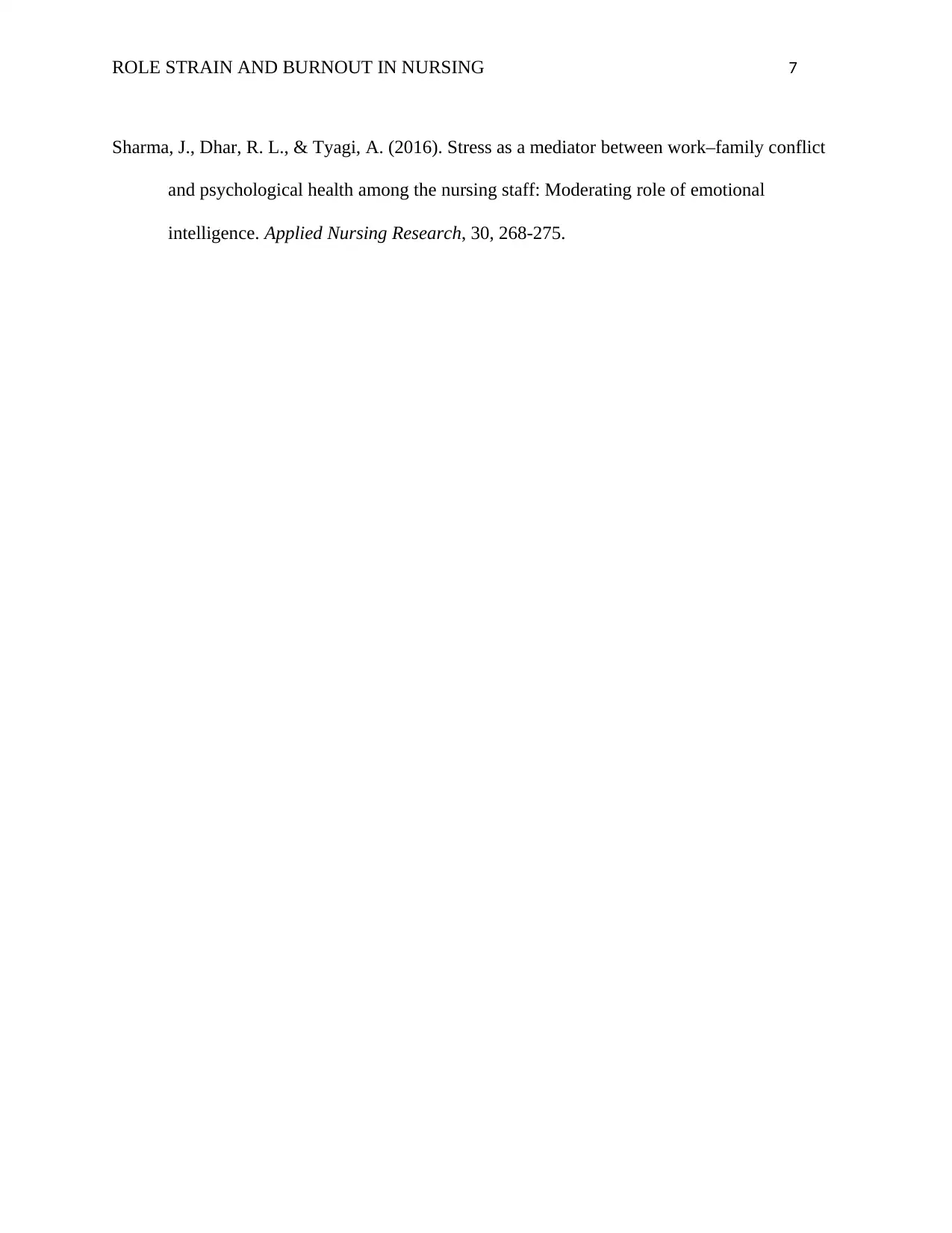
ROLE STRAIN AND BURNOUT IN NURSING 7
Sharma, J., Dhar, R. L., & Tyagi, A. (2016). Stress as a mediator between work–family conflict
and psychological health among the nursing staff: Moderating role of emotional
intelligence. Applied Nursing Research, 30, 268-275.
Sharma, J., Dhar, R. L., & Tyagi, A. (2016). Stress as a mediator between work–family conflict
and psychological health among the nursing staff: Moderating role of emotional
intelligence. Applied Nursing Research, 30, 268-275.
1 out of 7
Related Documents
Your All-in-One AI-Powered Toolkit for Academic Success.
+13062052269
info@desklib.com
Available 24*7 on WhatsApp / Email
![[object Object]](/_next/static/media/star-bottom.7253800d.svg)
Unlock your academic potential
© 2024 | Zucol Services PVT LTD | All rights reserved.





